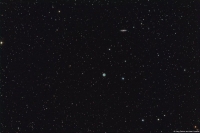The imaging object for this month is actually a pair of objects lying in the constellation Ursa Major. M97 also known as the Owl nebula is a lovely little planetary nebula, so named as it has a pair of dark round spots in its green interior which look like a pair of Owl’s eyes. It is very small at only 170″ in diameter and it is also quite faint at magnitude 9.9. Close by there is another Messier object, a small spiral galaxy M108 which measures 8.7′ x 2.2′ and is similarly faint at magnitude 10. Normally a long focal length is used so that there is a reasonable image scale for the Owl nebula, but if both objects are to be captured we need to work at shorter focal lengths. In the accompanying image the focal length is much too short really to bring out the two objects well, but it still seems to work by showing them in their largely barren environment. Surprisingly a couple of other “smallish” objects also do well in large field images including the Crab Nebula and M13 the Great Globular Cluster in Hercules.
At this time of the year we find Ursa Major near the zenith so we benefit from the best dark skies from our site and also minimum atmospheric interference. M97 and M108 still need plenty of exposure time however, like any object, and a minimum of 4 hours using 5-minute subs is recommended for either the f#4.5 Sky 90 system, or even the f#2 Hyperstar III scope.
We are now being forced to start imaging at indecently late hours as summer approaches and if like me you have a day job you are approaching the end of your imaging season until later in the year 🙁


